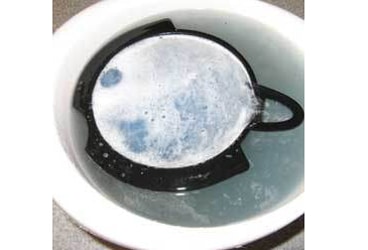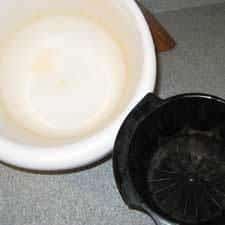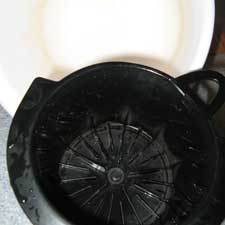
Reader Tip: using denture cleaner aboard
Over the past 5 years or so, I’ve gradually found more and more uses for denture tablets (you know, like Polident or Efferdent . . . except I buy cheap generic ones). I started buying them to clean the inside of my Thermos bottles. Then I kept finding more and more uses.
Denture tablets are great on a boat because they take up so little space compared to many other cleaners (some of which are mostly water) and they can be used on all sorts of things — many of which are hard to clean otherwise, particularly without a dishwasher. They’re usually cheap, too.
In general, they’re good on food and grease, and on items where it’s hard to get a brush in and really scrub. They’re good on hard surfaces and some softer materials.
DO NOT use denture tablets on any jewelry that’s not gold, platinum or hard precious stones (diamonds are fine; silver and pearls are emphatically NOT). When in doubt, don’t use them unless it’s something that you’d be willing to lose.
If you’ve never used denture cleaner tablets (I had a retainer in junior high and high school and used them then), it’s pretty simple: fill a container with water, drop a tablet (or more, see below) in the water and add the item to be cleaned. It will start fizzing, most brands turn the water blue initially (but I’ve seen other colors) and you let it sit until the water turns close to clear again — generally in about 30 minutes. With most items, you’re fine to leave things in overnight. Then remove the item and rinse. Sometimes I have to do a bit of scrubbing or use a Q-Tip to get into a corner, but I find that the denture cleaner has always significantly loosened, if not totally removed, the crud.
I find that I have to use about 1 tablet per cup of water — but I just guesstimate, it’s not an exact science. It works best with warm-ish water, but I don’t bother to heat it up as dentures should never be put in hot water (they can warp) and thus the cleaner is designed for room-temperature water.
To give you an idea of how it works, here’s a stained plastic bowl and the grounds basket from my coffee maker (we used a Melitta cone on the boat and I truly hated trying to keep the accumulated oils cleaned out of it until I tried this). Below is the “before” and under that is “after” about 45 minutes soaking and about 30 seconds with a couple of Q-Tips on the coffee basket.


It’s a little hard to see, but the bowl was seriously stained from some spaghetti sauce. I had scrubbed and scrubbed with dish soap and cleanser to get it to what it was in the “before” shot. It’s not perfect in the “after” but it’s much better — and was far less work.
The coffee basket is harder to see (could there be a reason they make them all brown, so you don’t see the gunk?). It had a LOT of accumulated oil on it that hot water and soap did nothing to dislodge, and I couldn’t even get a toothbrush around those little “fins” in the bottom. When I pulled it out of the denture cleanser water, it looked a lot better, and then I ran Q-Tips over all those little nooks and crannies in the bottom and got virtually all the crud out. I didn’t have to scrub at all!
So, what else have I found that they work on?
• Anything made of glass — particularly hard water stains and iced tea stains.
• Glass baking dishes (Pyrex or generic) — getting baked on crud off, as well as residue from non-stick sprays.
• Stainless pots and pans — any baked or burned on crud. DO NOT use on nonstick pans, and I’d be careful using it on any pan that wasn’t stainless (I haven’t tried it, but I’m afraid there might be a less-than-desirable reaction with an aluminum pan).
• Any type of a Thermos, carafe, vacuum bottle or air pot.
• Coffee pot.
• The bottle I store iced tea in (an old clear plastic juice container).
• Reusable water bottles (particularly if I’ve made Gatorade or something else with sugar in them).
• Coffee and tea mugs (particularly stained Melamine ones), including our insulated mugs.
• Iced tea glasses (ours are plastic and were OK, but I’d try it on one before soaking all of yours just in case it takes any design off — this is at your own risk!).
• It also helps significantly if you have any food storage container (“Tupperware”) that had spoiled food in it.
For more tips on how to get the most out of your galley, visit The Boat Galley.
Do you have a simple solution for a problem on board? Send your idea and a photo to HOS@cruisingworld.com. If we use your tip in the newsletter, we’ll send you a cool Cruising World_** Hands-On Sailor t-shirt!**_








